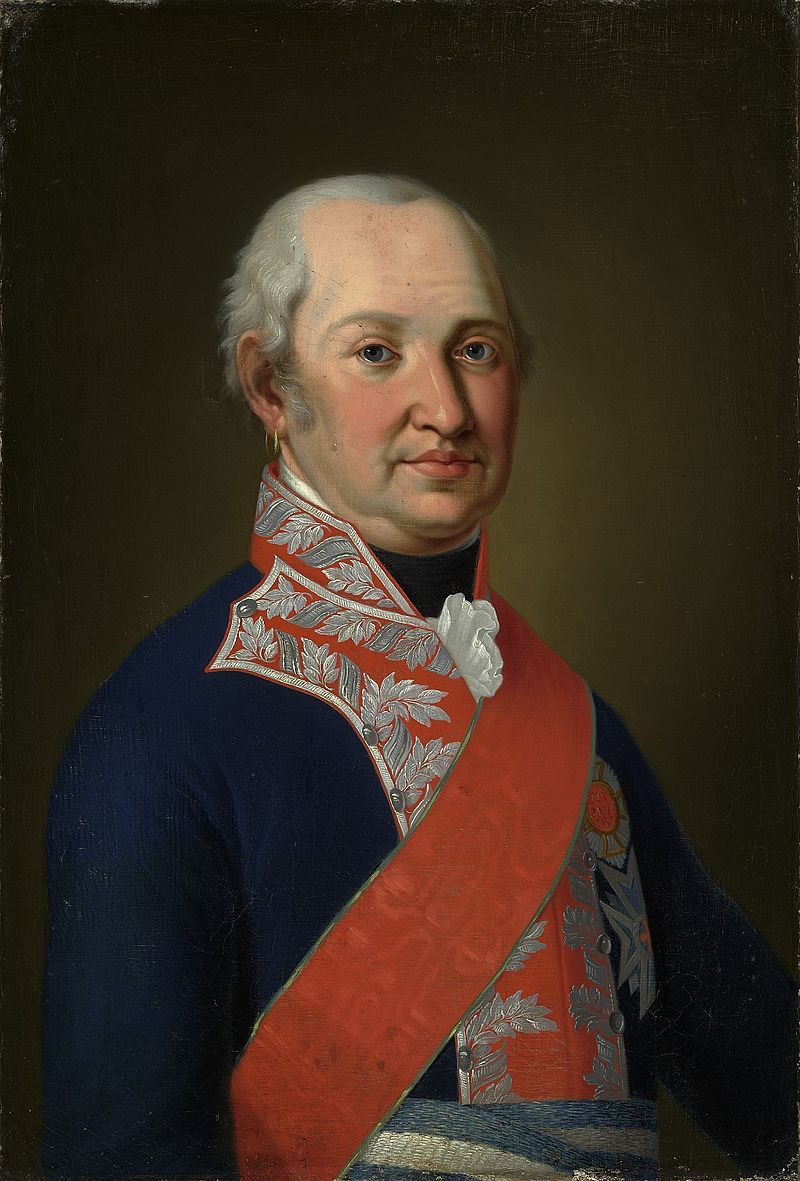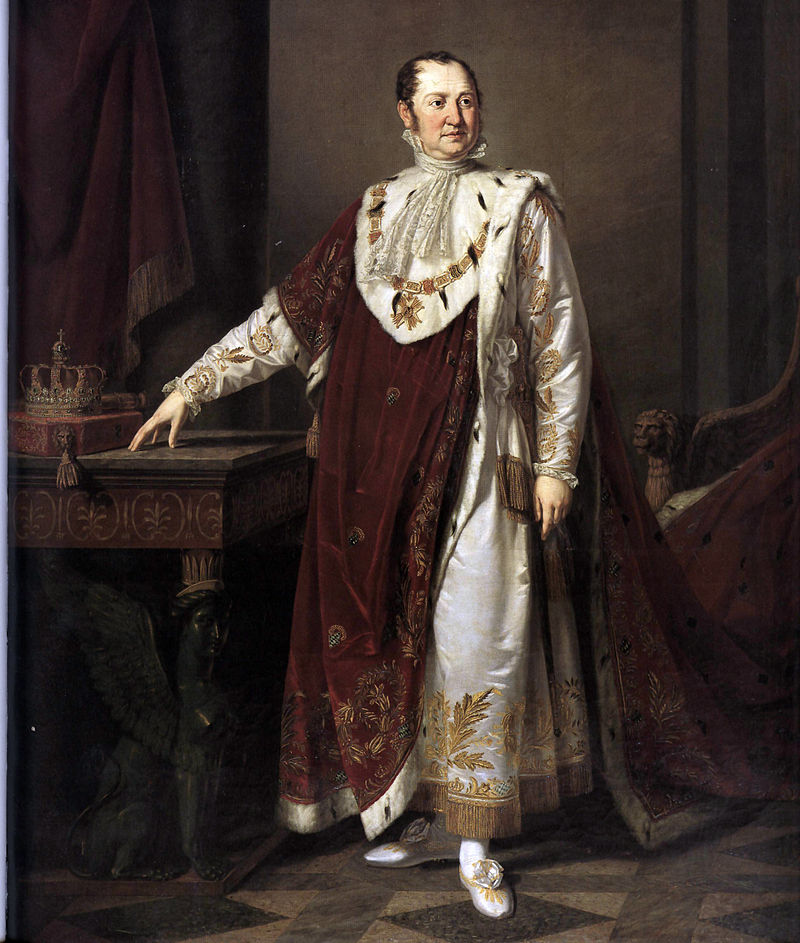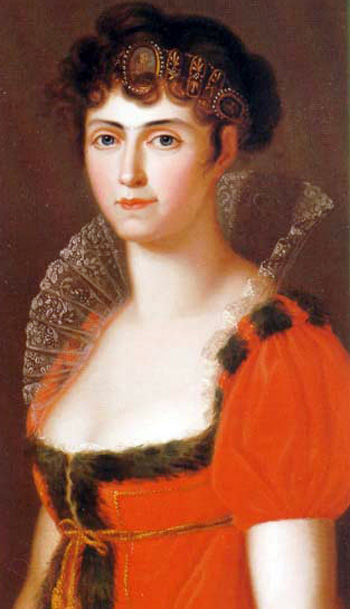by Emily McMahon and Scott Mehl © Unofficial Royalty 2013
Kingdom of Bavaria: The House of Wittelsbach ruled as Dukes, Electors, and Kings of Bavaria from 1180 until 1918. Today Bavaria is a landlocked federal state of Germany, occupying its southeastern corner. Maximilian IV Joseph, Prince-Elector of Bavaria allied his electorate with Napoleon and adopted many of the French beliefs of the Enlightenment. It was this loyal service to Napoleon through which Maximilian’s electorate was created the Kingdom of Bavaria with Maximilian at its king. He officially became the Maximilian I Joseph, the first King of Bavaria on January 1, 1806. On November 13, 1918, King Ludwig III would be the first monarch in the German Empire to be deposed at the end of World War I, bringing an end to 738 years of rule by the Wittelsbach dynasty.
*********************

Maximilian I Joseph, King of Bavaria – source: Wikipedia
King Maximilian I Joseph was the first King of Bavaria, reigning from 1806 until his death in 1825. He was born on May 27, 1756, in Schwetzingen, Electorate of the Palatine, now in Baden-Württemberg, Germany, the son of Friedrich Michael, Count Palatine of Zweibrücken-Birkenfeld and Maria Franziska, Countess Palatine of Sulzbach.
He had four older siblings:
- Karl II August, Duke of Zweibrücken (1746-1795) – married Princess Maria Amalia of Saxony, had issue
- Klemens August (1749-1750) – died in infancy
- Maria Amalie (1752-1828) – married King Friedrich August I of Saxony, had issue
- Maria Anna (1753-1824) – married Duke Wilhelm in Bavaria, had issue
Maximilian was educated under the watchful eye of his uncle, Christian IV, Duke of Zweibrücken, and several years after his father’s death in 1767, he was set up with his own household at the Hôtel des Deux-Ponts in Strasbourg, France which was purchased by his uncle in 1770. Maximilian would remain at the Hôtel des Deux-Ponts until 1790.
Maximilian joined the French army stationed in Strasbourg, and quickly rose through the ranks, attaining the rank of Major General. Following the French Revolution and the occupation of Zweibrücken during the Napoleonic Wars, Maximilian joined the Austrian army. He succeeded his brother Charles as Duke of Zweibrücken in 1795 and became Elector of Bavaria, Duke of Berg, and Count Palatine of the Rhine on February 16, 1799.

King Maximilian I Joseph, c1806. source: Wikipedia
Despite his switch in service to the Austrian army, Maximilian allied his electorate to Napoleon and adopted many of the French beliefs of enlightenment. Because of this loyal service to Napoleon, Maximilian’s electorate was created a kingdom with Maximilian at its head. He officially became the first King of Bavaria on January 1, 1806. In March 1806, he ceded the Duchy of Berg to Joachim Murat, Napoleon’s brother-in-law.
Shortly before the decisive Battle of Leipzig, Maximilian parted with his ally Napoleon to fight with Prussian, Russian, Swedish, and Austrian forces. Maximilian allied with the forces against Napoleon on the condition that if Napoleon’s forces were defeated, Bavaria would remain a kingdom. Following Napoleon’s downfall, Maximilian had a territorial dispute with Austria that lasted several years. One of the most powerful rulers in what is now Germany, Maximilian strongly supported the sovereignty of the individual duchies, principalities, kingdoms, and city-states within a larger German Confederation.
As one of the more liberal rulers during the first half of the 19th century, Maximilian granted Bavaria a constitution in 1816. Maximilian also made Munich a center for the arts in Bavaria, founding the Academy of Fine Arts and commissioning the construction of the National Theatre.

Princess Auguste of Hesse-Darmstadt. source: Wikipedia
on September 30, 1785, in Darmstadt, Landgraviate of Hesse-Darmstadt, now in the German state of Hesse, Maximilian married Princess Auguste of Hesse-Darmstadt, the daughter of Prince Georg Wilhelm of Hesse-Darmstadt and Countess Maria Luise Albertine of Leiningen-Falkenburg-Dagsburg.
They had five children:
- King Ludwig I of Bavaria (1786 – 1868), married Princess Therese of Saxe-Hildburghausen, had nine children including King Maximilian II of Bavaria and King Otto of Greece
- Princess Augusta of Bavaria (1788 – 1851), married Eugène de Beauharnais, Duke of Leuchtenberg, the son of Empress Joséphine of the French from her first marriage, had seven children including Joséphine who married King Oscar I of Sweden, Auguste who married Queen Maria II of Portugal, and Amélie who married Pedro I of Brazil
- Princess Amalie (1790 – 1794), died in childhood
- Princess Caroline Augusta (1792 – 1873), married (1) the future King Wilhelm I of Württemberg, no children (2) Emperor Franz I of Austria, no children
- Prince Karl Theodor (1795 – 1875) married (1) Maria de Pétin, had three children (2) Henriette Schöller, no issue

Princess Caroline of Baden. source: Wikipedia
Auguste died in March 1796, and the following year, on July 9, 1797, in Karlsruhe, Margraviate of Baden, now in the German state of Baden-Württemberg, Maximilian married for a second time, to Princess Caroline of Baden, daughter of Carl Ludwig, Hereditary Prince of Baden and Landgravine Amalie of Hesse-Darmstadt. Maximilian and Amalie had seven children including two sets of twin daughters:
- Prince Maximilian (1800-1803) – died in childhood
- Princess Elisabeth Ludovika (1801-1873) – married King Friedrich Wilhelm IV of Prussia, no issue
- Princess Amalie Auguste (1801-1877) – married King Johann of Saxony, had issue
- Princess Sophie Friederike (1805-1872) – married Archduke Franz Karl of Austria, had issue including Franz Joseph I, Emperor of Austria
- Princess Maria Anna (1805-1877) – married King Friedrich August II of Saxony, had issue
- Princess Ludovika Wilhelmine (1808-1892) – married Duke Maximilian Joseph in Bavaria, had issue
- Princess Maximiliana (1810-1821) – died in childhood

Tombs of King Maximilian I and his second wife, Queen Caroline, at the Theatinerkirche in Munich. Photo: © Susan Flantzer
King Maximilian I died on October 13, 1825, at the Nymphenburg Palace, in Munich, Kingdom of Bavaria, now in the German state of Bavaria, and is buried in the crypt at the Theatinerkirche in Munich. His heart is interred at the Shrine of Our Lady of Altötting.
This article is the intellectual property of Unofficial Royalty and is NOT TO BE COPIED, EDITED, OR POSTED IN ANY FORM ON ANOTHER WEBSITE under any circumstances. It is permissible to use a link that directs to Unofficial Royalty.
Bavaria Resources at Unofficial Royalty
